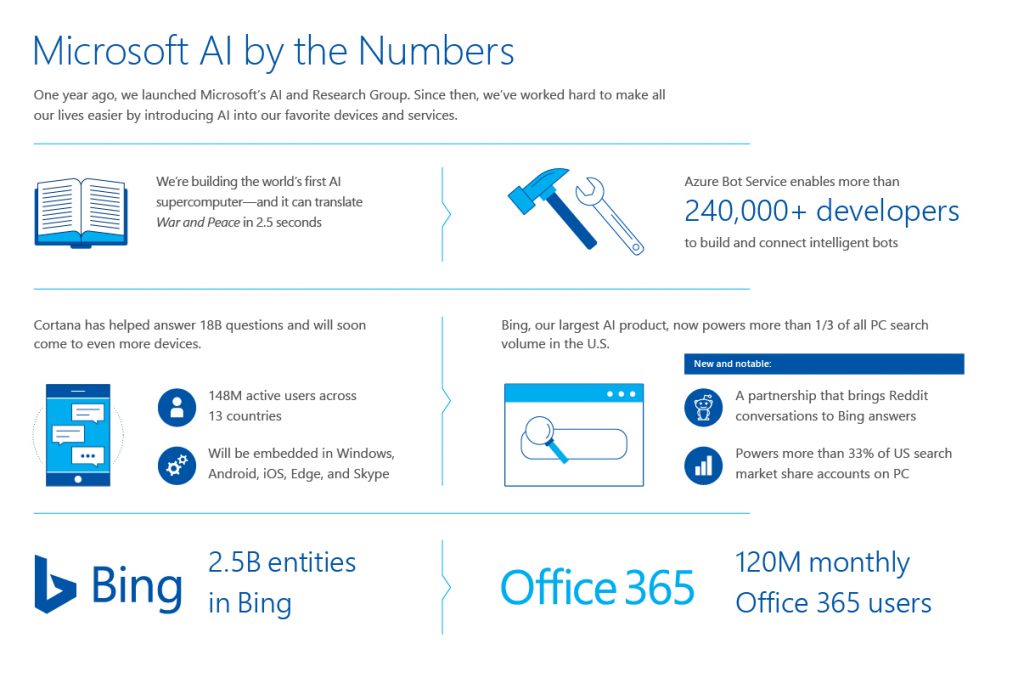
People want more intelligent technology tools. AI is helping with that.
Think back to the early days of the Internet. Chances are, you used a search engine like you might previously have used a phone book: To find a specific piece of information, such as a website, address or phone number.
Technology has changed significantly in the years since, and so have our expectations for it. These days, people want more intelligent answers: Maybe they’d like to gather the pros and cons of a certain exercise plan or figure out whether the latest Marvel movie is worth seeing. They might even turn to their favorite search tool with only the vaguest of requests, such as, “I’m hungry.”
When people make requests like that, they don’t just want a list of websites. They might want a personalized answer, such as restaurant recommendations based on the city they are traveling in. Or they might want a variety of answers, so they can get different perspectives on a topic. They might even need help figuring out the right question to ask.
At a Microsoft event in San Francisco on Wednesday, Microsoft executives showcased a number of advances in its Bing search engine, Cortana intelligent assistant and Microsoft Office 365 productivity tools that use artificial intelligence to help people get more nuanced information and assist with more complex needs.
These offerings, which build on the progress Microsoft has made in the past year in integrating AI across its product line, are the most recent examples of how engineers and computer scientists are using AI to help people do much more than just classify information.
“AI has come a long way in the ability to find information, but making sense of that information is the real challenge,” said Kristina Behr, a partner design and planning program manager with Microsoft’s Artificial Intelligence and Research group.
Jordi Ribas, Microsoft’s corporate vice president in charge of AI products, noted that when people think of AI, they often think of robots or AI-powered vehicles. What many people don’t realize is that AI also is having a tangible, useful impact on most people’s day-to-day lives, through products like search or Office 365 that they use every day.
“AI has really been integrated into society for many years,” Ribas said. “Sometimes, people have been using AI for a long time and they don’t even realize it.”
At the event in San Francisco, Microsoft demonstrated some of the most recent AI-driven advances in intelligent search that are aimed at giving people richer, more useful information.
They include visual search, which uses computer vision and object recognition advances to help people more easily track down information about something shown in a picture, and machine reading comprehension, which uses deep learning to read content and understand its deeper context, such as knowing that a cousin is a family member.
Bing also is working on a system to help users get to the information they are looking for even if they aren’t exactly sure how to find it. For example, let’s say you are trying to turn on Bluetooth on a new device. The new system could prompt users to provide more information, such as the type of gadget or operating system they are using.
Another new, AI-driven advance in Bing is aimed at getting people multiple viewpoints on a search query that might be more subjective. For example, if you ask Bing “is cholesterol bad,” you’ll see two different perspectives on that question. That’s part of Microsoft’s effort to acknowledge that sometimes a question doesn’t have a clear black and white answer.
Ribas said these intelligent search tools are part of Bing’s effort to make sure they are meeting people’s evolving expectations for finding information. That includes recognizing that people are increasingly turning to the Internet for opinions and analysis in addition to facts. He said Bing is aiming to meet that need while also making clear distinctions between a factual piece of information that has one definitive answer – such as when Alexander Hamilton was born – and an analysis or opinion that might have multiple perspectives, such as whether “Hamilton” is a good musical.
“As Bing, what we want to do is we want to provide the best results from the overall web. We want to be able to find the answers and the results that are the most comprehensive, the most relevant and the most trustworthy,” Ribas said. “Often people are seeking answers that go beyond something that is a mathematical equation. We want to be able to frame those opinions and articulate them in a way that’s also balanced and objective.
As part of that effort, Microsoft also announced a partnership with the social news aggregation site Reddit, to surface perspectives from Reddit conversations and different Reddit communities in Bing search engine results, when that information could be useful.
Bing also announced plans to surface results from Reddit’s famous AMAs – an acronym for “ask me anything” – that the site has conducted with the likes of Barack Obama and Bill Gates.
Alexis Ohanian, Reddit’s co-founder, noted that Reddit has a unique set of data that you can’t find anywhere else in the world, full of detailed expertise on everything from the best oils for beard grooming to the most delicious way to make gluten-free pancakes. What’s more, the community’s system of voting up helpful answers may help people find information other people have found useful.

Ohanian said Microsoft, in turn, has a skill Reddit doesn’t – the ability to quantify and analyze this dataset to deliver useful information to people via Bing search results.
Taken together, he thinks the two companies will be able to provide people with better search results from a community of experts they wouldn’t otherwise have access to.
“We can actually handle complicated, nuanced questions,” he said.
Information where, and how, you want it
Think back again to the old days of Internet search. Chances are, back then you did most of your searching at your desk, on your computer. These days, people want information wherever they are, and they want to be able to access it even if they don’t have their hands free to type, or their eyes free to look at a screen.
Much of the functionality in Microsoft’s personal digital assistant, Cortana, is powered by its Bing search engine, and Behr said many of the advances in Bing will help people get more useful information when they don’t have the luxury of a screen and a keyboard. That’s where things like machine reading comprehension, which summaries search results, and conversational search, which asks follow-up questions, can come in handy.
Those advances aren’t just applicable to web searches.
At the San Francisco event, Microsoft showed how Cortana can do things like sort emails and provide a summary of the most important ones — such as an email from your boss or your spouse – on your commute home. That functionality works even if those emails are, say, a mix of personal emails from your Gmail account and work emails from your Outlook account.
The company also showed off a feature in Cortana called skills chaining, which suggests another skill that might be useful to you. For example, if you are using Cortana to book tickets to an event, Cortana might suggest that you add it to your calendar as well.
Behr noted that we are still in the early days of figuring out how best to get people useful information when they are using another device besides a traditional computer. She said that’s why the company is approaching it both as a technical issue and a design issue.
“We are still kind of scratching the surface on what this looks like,” she said.
AI in Office 365
You have to think back to the days before the internet was widely used to remember a time when Microsoft Word didn’t at least have a spell checker to help you find the occasional typo or misspelled word.
These days, people count on Office 365 for a lot more than just a basic spell check – we rely on it to make writing suggestions in Word documents, automatically design presentations in PowerPoint and sort emails by importance in Outlook.
Rob Howard, director of product marketing for Office, said that many of these subtle time savers are – and have long been – powered by AI, even though customers may not realize it.
“We think of Office as one of our biggest ways of getting AI into the hands of people,” Howard said. “People use these features to be more efficient, be a better writer or create more beautiful, impactful presentations.”
Howard noted that many of these functions are about doing lots of little things for people – like automatically fixing typos or suggesting photo placement – that save lots of time over the long run. Increasingly, the company also can offer AI-driven tools for bigger tasks that used to require an AI expert.
At the AI event on Wednesday, Microsoft announced the preview of Insights in Excel. It uses a branch of AI called machine learning to analyze data in Excel spreadsheets and create pivot tables and charts showing trends and other useful information.
“Data is incredibly valuable, but it’s only valuable when you’re actually able to extract insights from it,” Howard noted.
Many other recent additions to Office 365 take advantage of, and make available, the huge amount of data that companies have, but that isn’t always easy to find. For example, let’s say you’re reading a document and you come across an acronym you don’t know. At the AI event on Wednesday, Microsoft announced plans to release a new Microsoft Word feature called Acronyms. It looks through Office documents and emails to help you find acronym definitions specific to your organization.
Another function, called Tap for Word, lets you surface relevant documents, spreadsheets and presentations from your organization without leaving the document you’re working in. That means you can, for example, add a profitability chart to a presentation without scrolling through hundreds of emails or corporate websites to find it.
Microsoft also announced plans to release a tool that highlights action items in email and gives you options for responding quickly on the go.
Many of these new offerings rely on the cloud to process information – and users are also getting constant improvements because Office 365 runs on the cloud.
For example, when Designer first shipped in PowerPoint, it was able to take a few photos and automatically create a layout. Now, it also can take a bulleted list, understand the user is outlining steps in a process and create a presentation highlighting those steps.
“The cloud has actually really accelerated our progress,” Howard said. “We’re able to take a lot of that functionality and bring it to end users more quickly.”
Lead photo: Jordi Ribas, left, and Kristina Behr, right, showcased Microsoft’s AI advances at an event Wednesday. Photo by Dan DeLong.
Related:
- Find out more about the announcements at the Everyday AI event
- Watch the keynote: Microsoft AI – Everyday, Everywhere, for Everyone
Allison Linn is a senior writer at Microsoft. Follow her on Twitter.
















